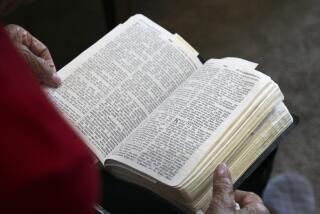The Folk Tales and Oral Lore Behind the Bible
- Share via
“If someone asks me what he should read as an introduction to folklore,” quipped folklorist Leopold Schmidt, “then I say to him: ‘Read Homer and the Old Testament!’ ”
The same provocative idea--and the same tinge of irreverence--can be found in “Holy Writ as Oral Lit,” a brief but illuminating excursus into the Bible as anthropology by UC Berkeley professor Alan Dundes. He approaches the Bible not as the revealed word of God but as a collection of folk tales that were passed down by one generation of storytellers to the next long before they were written down on parchment or paper as “codified oral tradition.” “If one weeded out the folklore,” goes his argument, “virtually nothing would be left.”
As suggested by the playful title of his book, Dundes asks us to entertain the idea that the Bible first emerged as folklore, a category that he defines as encompassing not only sacred myth and heroic legend but also “riddles, superstitions, curses, charms, tongue twisters and games.” Thus, Dundes is much less interested in the sense of the sacred that the Bible was meant to convey than he is in the “folkloristic nature” of its wordplay.
In fact, much of what Dundes proposes goes against the conventional wisdom of classical Bible scholarship. For example, he does not share the assumption of the typical Bible scholar that the written word is inherently more authentic than a tale told around a campfire. Dundes insists that the very opposite was true in distinct antiquity: “In biblical times written documents were of lesser importance,” Dundes argues, “and had to be confirmed by oral testimonies.”
Crucial evidence that the Bible began as a purely oral tradition, he suggests, is provided by the “doublets” scattered through the biblical text; that is, the same story told more than once but with variations in each telling. Bible scholars suggest that doublets result from the multiple authorship of the Bible. According to mainstream scholarship, these biblical sources are imagined to have been authors and editors whose original work product was ink on parchment.
Dundes reaches an entirely different conclusion from the same evidence, insisting that the “multiple existence and variation” of stories in the biblical narrative proves that the ultimate sources were storytellers. “From a folkloristic perspective, there can be no doubt whatsoever that doublets and triple repetitions demonstrate a likely oral origin,” Dundes insists. “I hope to show that virtually every major event in both the Old and New Testament exists in at least two versions.”
Thus, as just one in a whole litany of examples, Dundes points out that Noah is depicted in the same chapter of Genesis as bringing animals aboard the ark in pairs and later “by sevens.” The duration of the flood is reported as 150 days in one passage and 40 days in another. And the bird that Noah set aloft to find dry land is a raven in one line and a dove in the very next line. Which version is the oldest and the most authentic? Dundes says it’s the wrong question to ask.
“One should keep in mind that in folklore there is no one correct version; there are only alternative versions,” Dundes writes. “This is precisely why oral history is so often the despair of historians who are distinctly uncomfortable when confronted with different oral historical accounts of the same event.”
The reader who comes to “Holy Writ as Oral Lit” with a traditional belief in the Bible as the word of God may be uncomfortable too. Even the more liberal reader may find it unsettling to discover that a passage as fundamental as the 10 commandments is presented in several different versions in the Bible, and so are the Lord’s Prayer and the Golden Rule. Dundes’ insights are hardly revolutionary--he is deftly summing up a century or so of conventional Bible scholarship from an anthropological perspective--but he offers some useful tools for extracting new meanings from even the oldest and most familiar texts.
Above all, Dundes insists that his approach and his conclusions are faithful to the authentic meanings of the Bible. For example, when challenged in the Gospel of Matthew by the Pharisees and the Sadducees to show “a sign from heaven,” Jesus responds with what Dundes calls a “weather superstition,” an early version of the familiar saying, “Red sky at morning, sailors take warning . . . “ “I believe Jesus would have understood my argument,” Dundes boldly asserts. “Jesus himself recognized that . . . oral tradition was a source of folk knowledge.”
Jonathan Kirsch, a contributing writer to the Los Angeles Times Book Review, is the author, most recently, of “Moses, a Life” (Ballantine).
